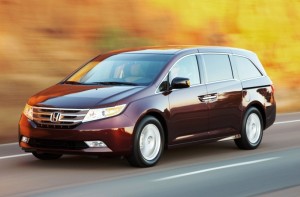If any automaker benefited from the crisis at Toyota, last year, it was Honda. Data suggests it was the only manufacturer to pick up a significant number of once-loyal Toyota owners during the industry giant’s problems with unintended acceleration and other safety-related issues.
But suddenly, it seems, Honda is having a spate of quality-related setbacks of its own – which could complicate matters as the company struggles through the effects of the earthquake, tsunami and nuclear meltdown trifecta that have so far shut down its Japanese operations for nearly three weeks.
The latest problem: the recall of 2,800 Odyssey minivans because of a defect that can result in the front windows coming off their tracks, rendering them inoperable. It’s the second recall of the latest-generation Honda van in just two weeks, following the callback of 33,000 Odysseys due to faulty windshield wipers.
The latest numbers are small – though any safety-related issue involving family-oriented minivans can be problematic beyond the actual number of vehicles recalled. What’s especially significant is the fact that, according to data filed with the National Highway Traffic Safety Administration, Honda had the third-highest number of vehicles involved in recalls of any automaker operating in the U.S. last year – and second-highest among Japanese — 2.4 million covered by 15 separate actions. (Nissan had 16 separate recalls but they involved just 2.1 million vehicles.)
Industry observers, such as Aaron Bregman, of IHS Automotive, caution that automakers have become much more cautious in light of Toyota’s ongoing problems, meaning they’re more likely to order a recall now than in years past. Nonetheless, Honda cannot afford to appear to be slipping in quality, safety or reliability at a time when it is facing increasing pressure from U.S., South Korean and European competitors.
The maker landed 11th in the latest J.D. Power Vehicle Dependability Survey, released earlier this month, behind other mainstream brands such as Toyota, Buick and, notably, Hyundai. (Click Here for that story.) It came in just a point ahead of Ford in the VDS, which measures long-term reliability.
Honda, meanwhile, lagged 12 points below the industry average in the latest J.D. Power APEAL study. Short for Automotive Performance, Execution and Layout, that survey of U.S. car buyers examines the factors, such as vehicle design, that often have as much influence on a motorist’s buying decision as quality and reliability, according to Power analyst Dave Sargent.
“When new-vehicle buyers go through the shopping process, vehicle appeal, along with price and perceptions of quality, is of major importance,” said Sargent. “Attributes such as exterior styling are primary determinants of whether a model makes the customer’s consideration list in the first place, while other attributes—particularly those related to the interior of the vehicle—are critical in determining which model is ultimately purchased.”
Significantly, Honda lagged behind not only top-sellers like Ford, Toyota and Chevrolet, but even second-tier Japanese marques, such as Mitsubishi and Mazda, as well as the now-discontinued Ford Motor Co. brand, Mercury.
One reason for the poor performance, suggested analyst Joe Phillippi, is that Honda’s “styling has gotten totally off-track.”
That has been apparent with the weak response given several recent additions to the Honda line-up, notably including the Insight hybrid and CR-Z, as well as the high-line Acura brand’s much-maligned ZDX crossover/coupe.
The Japanese maker, which slipped behind Nissan to become the third-largest Japanese maker, last year, is hoping to reinvigorate its line-up with the launch of an all-new Civic, which is scheduled to reach market in April.
But that introduction could run afoul of Honda’s ongoing problems in the wake of the March 11 natural disaster that devastated much of northeastern Japan.
Honda was the only maker, in fact, to report a death at one of its facilities, a worker killed when the 9.0-magnitude temblor brought down the well of a cafeteria at its Tochigi R&D center. That facility, TheDetroitBureau.com has reported, is now expected to be out of operation for months, which could delay a number of product development programs. (Click Here for that full story.)
Honda’s Japanese production has remained on hold and it is unclear how soon operations will resume. The maker meanwhile advised workers in the U.S. that some plants here could soon be idled due to the shortage of Japanese-made parts.
That’s a problem not limited to Honda; even Detroit and European makers are facing similar shortages, GM already having idled a factory in Louisiana for a week. But considering the importance of the new Civic, a delay could prove seriously problematic, especially if supplies of the old model dwindle.
Analysts stress that Honda is still a strong and well-respected marque, but the various problems now facing the brand could make for some serious challenges in the year ahead, especially if it continues to face well-publicized recalls.


Very informative article. Thank you!!